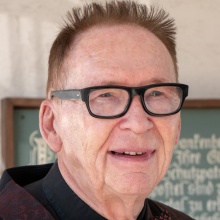Obituary of Prof. Erik Grafarend
(1939–2020)
On 8 December 2020, Prof. Dr.-Ing.habil. Dr.tech.h.c.mult. Dr.-Ing.e.h.mult. Erik W. Grafarend, professor emeritus at the University of Stuttgart, died at the age of 81.
Erik Wilhelm Grafarend was born in Essen on 30 October 1939. After completing his studies in Mine Surveying (1964) at the University of Clausthal-Zellerfeld, Erik Grafarend pursued a rapid geodetic career with a doctorate (1966) and a second degree in physics (1968) at the same university. He moved to the University of Bonn where he habilitated in 1970 and received the Venia Legendi for the subject “Theoretical Geodesy”; the habilitation thesis was entitled “The Accuracy of a Point in Multidimensional Euclidean Space”. In 1971, at the young age of 32, he became an adjunct professor at the Institute for Theoretical Geodesy at the University of Bonn. This was followed in 1975 by an appointment to the chair of “Astronomical and Physical Geodesy” at the University of the Federal Armed Forces in Munich. In 1980, Prof. Grafarend was appointed successor to Prof. Karl Ramsayer at the University of Stuttgart, where he headed the Institute of Geodesy until 2005. Since his retirement in 2005, he continued to be active in geodesy as a researcher and, in particular, as a book author.
Prof. Grafarend's research activities were by no means limited to the actual dedication of his chair. Known for his extraordinarily broad interest, even curiosity, he covered a thematically wide spectrum of geodesy: physical geodesy, estimation theory, statistics, geodetic network design, satellite geodesy, differential geometry, map projections, geo-kinematics, earth rotation, inertial navigation, reference systems.
The diversity of his research is documented on the one hand in an extensive oeuvre of around 350 publications in relevant scientific journals and conference proceedings. On the other hand, Erik Grafarend has left a series of substantial books to geodetic posterity, amongst others “Map projections: cartographic information systems”, “Applications of linear and nonlinear models: fixed effects, random effects, and mixed models”. His most recent book projects include Gravitation and the editorship of the “Encyclopedia of Geodesy”. Beyond its diversity and size, Erik Grafarend's oeuvre is characterised by a creative power that has an almost artistic quality.
The geodetic work of Prof. Grafarend was highly recognised throughout his life. He was the first recipient of the prestigious Bomford Prize of the International Association of Geodesy in 1975. He has received numerous honorary doctorates and professorships from universities at home and abroad: Royal Institute of Technology in Stockholm (1989), TU Darmstadt (1996), TU Budapest (1998), University of the Federal Armed Forces in Munich (2000), University of Tehran (2002), University of Navarra in Pamplona (2014). He was a member of various learned societies: the German Geodetic Commission of the Bavarian Academy of Sciences, the Leibniz-Sozietät der Wissenschaften zu Berlin, the Finnish Academy of Sciences, the Hungarian Academy of Sciences, the Austrian Geodetic Commission.
In various functions in committees of national and international geodesy, Prof. Grafarend showed leadership. Within the DVW, he founded Working Group 7 "Experimental, Applied and Theoretical Geodesy"; for him, the name was the programme. As head of AK7, he founded the successful Geodetic Week, initially as an independent event with a special focus on young scientists, later established within InterGeo. In international geodesy, Erik Grafarend was clearly visible and, at conferences, also audible. In 1980 he was a founding editor of the journal manuscripta geodaetica, forerunner of the Journal of Geodesy. In the IAG he chaired various Special Study Groups and was elected President of the IAG Section IV “General Theory and Methodology” in 1983.
International networking has always been a special concern for Prof. Grafarend, but also a matter of course. He spent shorter and longer teaching and research stays in Columbus, Tehran, Wuhan, Sydney, Bandung, Uppsala, Stockholm and, regularly, Helsinki. Numerous top international scientists of the younger generation were motivated by him to conduct research with him in Stuttgart, among other things through funding from the Alexander von Humboldt Foundation. In recognition of his merits in promoting international scientific cooperation, he was awarded the Werner Heisenberg Medal of the Humboldt Foundation in 2000.
With Prof. Erik W. Grafarend we are losing a beacon of geodesy. He was an outstanding scientist whose interests and productivity knew hardly any boundaries, and whose contributions are inseparably linked to the development of modern geodesy. Nationally and internationally, he was valued as a colleague, as a teacher and, for many who knew him, as a friend. The beginnings of his scientific career could well have steered him into geophysics or physics. By a stroke of luck, geodesy became his home.
Nico Sneeuw, Stuttgart


